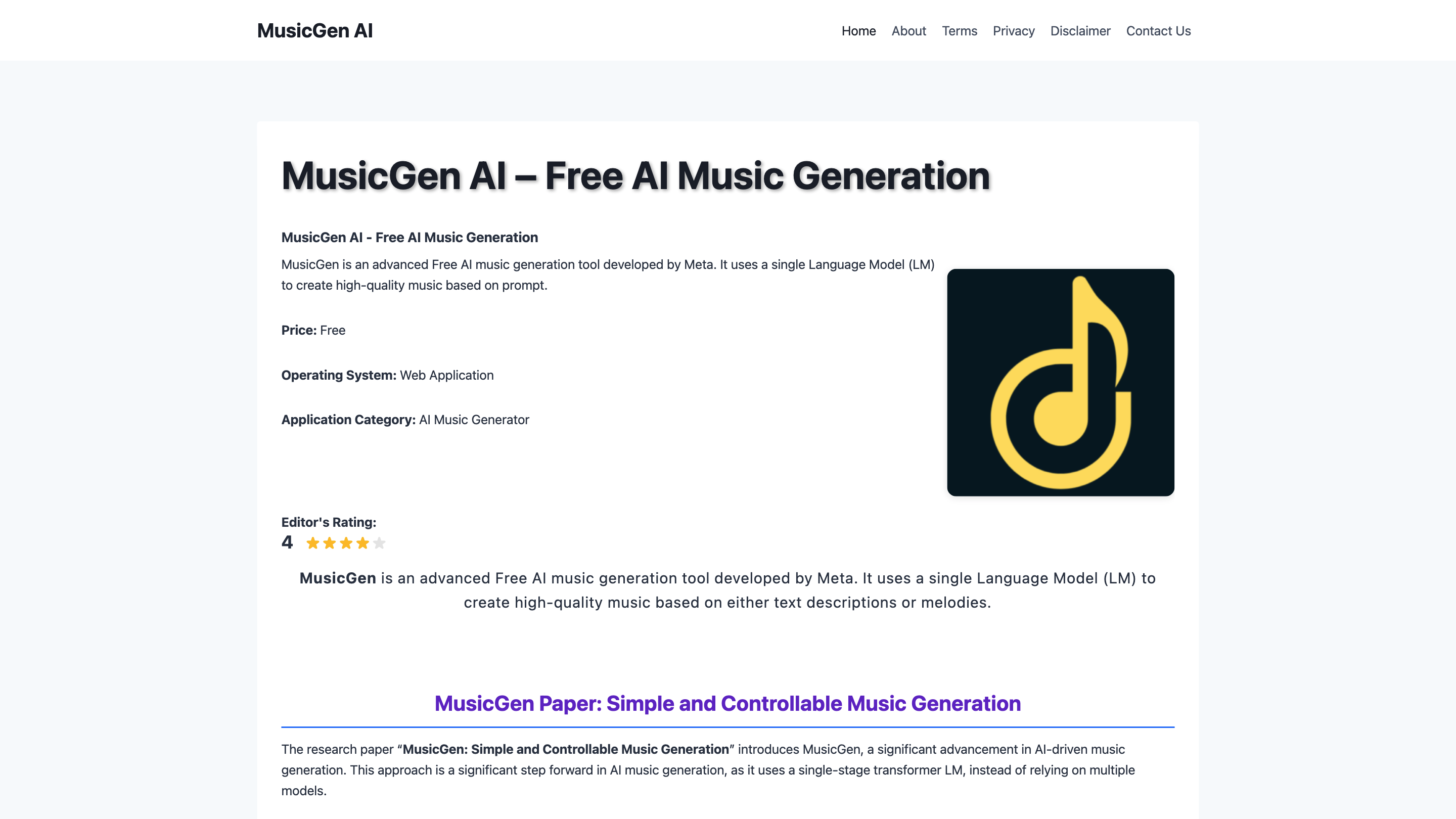MusicGen AI
Open siteMusic & Audio
Introduction
Free AI music generation tool.
MusicGen AI Product Information
MusicGen AI - Free AI Music Generation is an advanced AI music generation tool developed by Meta. It uses a single Language Model (LM) to create high-quality music based on prompt input (text descriptions, melodies, or audio prompts). The system supports unlimited, copyright-free music generation and emphasizes accessibility, flexibility, and controllable output through various generation modalities.
Key Highlights
- Free, open-access AI music generator leveraging a single-stage transformer LM.
- Generates music from text prompts, melodies, or audio inputs.
- Capable of producing mono and stereo outputs with configurable audio details.
- Based on research from the paper “MusicGen: Simple and Controllable Music Generation.”
- Trained on a large, licensed music dataset to enable diverse styles and genres.
Core Features
- Melody Conditioning: generate music guided by melodic structures from other audio tracks or user-created melodies.
- Text-Conditional Generation: create music driven by descriptive prompts (genre, tempo, mood, instruments, etc.).
- Audio-Prompted Generation: use existing audio clips as a basis for new music.
- Flexible Model Architecture: includes a text encoder, LM-based decoder, and audio encoder/decoder for versatile generation.
- Generation Modes: supports greedy and sampling generation; sampling often yields more varied results.
- Unconditional Generation: can produce music without explicit prompts.
- Extensive Training Data: trained on ~20,000 hours of licensed music, enabling high-quality outputs.
- Customizable Parameters: adjust guidance scale, maximum length, and other generation controls.
- Platform Compatibility: usable via web interfaces (e.g., Hugging Face) and local setups.
- Commercial Use: open-source and usable for commercial purposes.
How MusicGen Works
- MusicGen encodes music into compressed tokens and decodes them to produce audio.
- A single-stage transformer LM handles generation, enabling straightforward prompt-based creation.
- Outputs support both mono and stereo formats, with stereo produced via dual codebooks for left/right channels.
How to Use MusicGen
- Access a MusicGen interface (e.g., Hugging Face Space or local WebUI).
- Provide a prompt or input a melody/audio-based guide:
- Text Prompt: describe genre, tempo, mood, instruments, etc.
- Melody Input: provide an existing melody as a conditioning signal.
- Audio Prompt: upload an audio clip to steer the style and feel.
- Configure generation parameters (e.g., length, guidance scale, sampling vs. greedy).
- Generate and download the resulting music file.
Running MusicGen Locally (Overview)
- Install prerequisites (Python, CUDA toolkit if using GPU).
- Clone the MusicGen/Audiocraft repository and set up a virtual environment.
- Install dependencies (requirements.txt) and FFmpeg for audio processing.
- Run the WebUI or demos to generate music from prompts or audio inputs.
- Optional: create desktop shortcuts or launch scripts for ease of use.
Note: Local setup steps may vary by environment and hardware; refer to the official repo for exact commands.
Safety, Licensing, and Legal Considerations
- MusicGen outputs are designed to be copyright-free or licensed per training data policies.
- Users should review licensing terms for generated works and ensure compliance with local laws and platform policies.
- For commercial use, comply with attribution and licensing guidelines where applicable.
System Requirements (Typical)
- Web access for online usage; local setup requires Python and GPU support for faster generation.
- Sufficient disk space for model weights and generated audio files.
- Optional: CUDA-compatible GPU for accelerated generation.
FAQs
- What is MusicGen? A free, open-source AI music generation tool by Meta using a single LM for text, melody, or audio-driven music creation.
- Can it generate various music styles? Yes, with a diverse training dataset and controllable prompts.
- Is it suitable for commercial use? Yes, open-source code and models permit commercial use under the provided licenses.
- Is unlimited generation possible? In practice, limits depend on hardware, compute access, and any platform-imposed constraints.
Pros and Cons (General)
- Pros: versatile, innovative, controllable parameters, high-quality output, easy access via web and open-source deployments, suitable for commercial use.
- Cons: may require technical setup for local use; quality depends on training data and prompt quality; GPU resources recommended for large-scale generation.
Related Resources
- MusicGen research paper: MusicGen: Simple and Controllable Music Generation
- MusicGen on Hugging Face: https://huggingface.co/spaces/facebook/MusicGen
- Audiocraft project and setup guidance for local deployment
